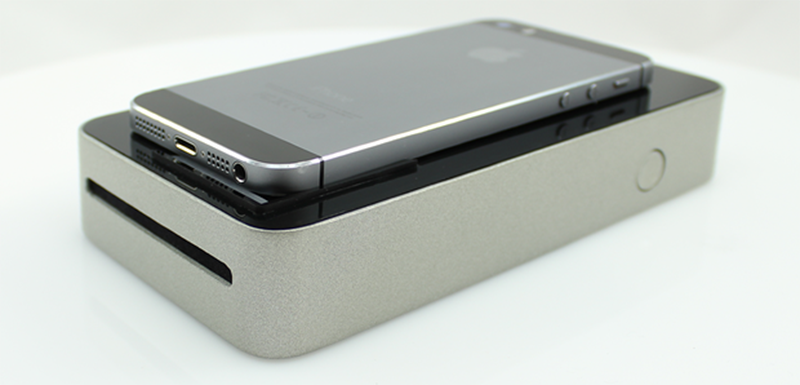Several decades ago, the all the punks and artsy types had terrible lenses with terrible camera that leaked light everywhere. Film was crap, and thus was born the fascinating world of Lomography, with effects and light leaks unique to individual cameras. Now, everyone has a smartphone with high-resolution sensors, great lenses, and Instagram to replicate the warm look of filters, light leaks, and other ‘artististic’ photographic techniques. The new version of this photography is purely in the digital domain, and wouldn’t it be great if there was a way to make your digital selfies analog once again? The SnapJet team has your back.
Instead of adding filters and other digital modifications to smartphone snaps, the SnapJet prints pictures onto Polaroid film. Yes, you can still buy this film, and yes, it’s exactly how you remember it. By putting a smartphone down on the SnapJet, you’ll only need to press a button, wait for the film to be exposed, dispensed, and developed. What comes out of the SnapJet is an analog reproduction of whatever is displayed on your phone’s screen, with all the digital filters you can imagine and the option to modify the photos in the analog domain; eac Polaroid can be turned into a transparency, with backlit LEDs being an obvious application:

 The current prototype of the SnapJet is an interesting exercise in sourcing components – the guts of the mechanism is torn from a Fuji instant camera. The version the team is working on will completely remake the mechanism, and release it as open source. Yes, this is a completely new mechanism for film that hasn’t changed in a few decades. It’s impressive work, and we can’t wait to see the finished version.
The current prototype of the SnapJet is an interesting exercise in sourcing components – the guts of the mechanism is torn from a Fuji instant camera. The version the team is working on will completely remake the mechanism, and release it as open source. Yes, this is a completely new mechanism for film that hasn’t changed in a few decades. It’s impressive work, and we can’t wait to see the finished version.
















How do you suppose they made the animated picture frame?
Isn’t it just a .gif of 5 different pictures?
It’s not Polaroid, it is an Fuji Instax Mini film. A slightly different device for the Polaroid films and their successor from Impossible Project is already available: the Impossible Instant Lab. They are using not a scanner with glass fibre, but a lens and shutter. But both devices will expose the image from the display onto the film. A bit archaic method, but I like it.
“Film was crap” is a bit of an unqualified statement to say the least…
It was crap.
The actual film cameras that most of us had back in the day weren’t shooting onto full 35mm frames. They were cheap 16 or even 9.5 and 8 mm cameras and the film was grainy as it gets with huge variations in sensitivity and color reproduction, and the photo labs didn’t do their jobs right, and neither did you if you tried to DIY, and nobody knew how to photograph anyhow because it took so long to get the results back that you completely forgot what you actually did.
@dax speak for yourself. please consider leaving ‘we’ and ‘us’ and ‘you’ out of your vocabulary.
if you used crappy cameras film etc you get crap. as far as i remember i took a nd dveloped some pretty good pics in my day. what i noticed lately there are more crappy pics around. by the way i agree there were some variations in lab work. Don’t have film developed the day after pay day there seemed to be a LOT of variations fron the
effects of alcohol the night before.SO you learned …….like everthing else and became GOOD at photography etc
This already happens two years ago: https://www.kickstarter.com/projects/impossible/impossible-instant-lab-turn-iphone-images-into-rea
I’m sorry, but both projects are retarded. It’s a camera that takes a picture of your phone’s screen. You don’t need anything special for that…
Yeah i agree with your point. But people like https://insta-fonts.com/ has still hope.
Great work
You can also use https://textandfonts.com/hacked-text-generator/ for best and unlimited free fonts.